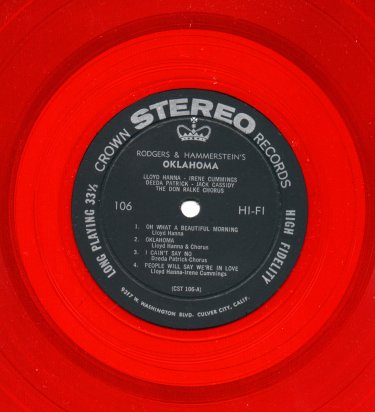 Crown albums started out by reissuing the material from Modern and RPM, which was often excellent
and sought-after. After running out of Modern and RPM reissues, Crown soon settled down to become
another of the low-budget labels putting out generic music, knockoffs of current hits, or deceptive artist
names meant to confuse the undiscerning buyer, much like Tops or Pickwick's labels. And Crown
became one of the earliest labels to start hawking music with a famous artist's name in huge letters, but
the music inside was by "members" of their former orchestra. Later labels like K-tel or Gusto learned
from the Biharis, re-recording hundreds of former rock/pop hits by "one or more members of the original
group." They also learned from the Biharis that avoiding royalties was a good thing if you wanted to
make money, so they offered their artists a flat fee for recording (see below).
Crown albums started out by reissuing the material from Modern and RPM, which was often excellent
and sought-after. After running out of Modern and RPM reissues, Crown soon settled down to become
another of the low-budget labels putting out generic music, knockoffs of current hits, or deceptive artist
names meant to confuse the undiscerning buyer, much like Tops or Pickwick's labels. And Crown
became one of the earliest labels to start hawking music with a famous artist's name in huge letters, but
the music inside was by "members" of their former orchestra. Later labels like K-tel or Gusto learned
from the Biharis, re-recording hundreds of former rock/pop hits by "one or more members of the original
group." They also learned from the Biharis that avoiding royalties was a good thing if you wanted to
make money, so they offered their artists a flat fee for recording (see below).
As the Bihari budget label, Crown quickly earned itself a reputation as a junk record label, and by sheer volume of issues and reissues became known as the King of junk record labels (yeah, they even have a crown...). Cost savings measures (= "cutting corners") were obvious everywhere. The covers were cheaply made, and fell apart almost instantly. The back slicks were the only thing that held the two slabs of cover cardboard together, and the paper didn't last long; finding a Crown album today without a seam split is indeed unusual. The back and front slicks themselves were often recycled unused slicks from old records; on many you can see the pictures from old front covers right through the paper. The front slicks were put on by hand, no doubt using unskilled (or uncaring) labor, as rarely were they put on straight (or maybe once in a while fortuitously put on straight).
The records themselves often sounded worn out right out of the package, with all kinds of bumps and wrinkles or other vinyl anomalies. The preference for material for release was public domain tunes so no royalties need be paid (check how many times the song "Ida" shows up - scores of times. How many other labels have that song?). Other songs were purchased outright for a few bucks from the artists used for recording, who were paid a flat fee for recording, with no possibilities of future royalties. Songs were recycled, too, with generic artists' names rotated so the same recordings could be used again and again under different names. Some masters were even "traded out" to other budget labels, who renamed the artists and provided Crown in turn with their generic recordings that Crown could name for themselves. For this reason, the same recordings would show up on several labels under several different artists' credits, and even under different song names (see the discussions under CLP-5055 and CLP-5174 for just two examples of this practice).
 Crown was much too cheap to issue special promotional copies; in fact, it's doubtful they ever gave
away promotional copies, with special labels or not.
Crown was much too cheap to issue special promotional copies; in fact, it's doubtful they ever gave
away promotional copies, with special labels or not.
An interesting aspect of the Crown albums was the artwork, especially the "Fazzio" covers, which were airbrushed photos that resembled oil paintings. These started after Crown has experimented with drawings of the artists (5278-5308). The first Fazzio cover was 5321 in mid-1963, and they continued until 5422 in mid-1964, except for a couple of recycled covers later. Actually, they had several philosophies as to cover art, and they changed these often. From 5310-5318 in 1963, they had a cover design that looked for all the world like it was made at World Pacific/Horizon records, and for all we know, it was. For a time, they tried knockoffs of other (charting) album covers to confuse potential customers who weren't too observant (e.g., 5150, which was a knockoff of the 101 Strings album The Soul of Spain, which had a similar but yellow cover, 5217 which was a Kingston Trio knockoff, and 5233, which was a Marty Robbins knockoff).
 Like most budget labels, there was plenty of cheesecake photos on covers, but most were tasteful and
avoided the records being rejected by record shops or grocery stores. About as far as Crown went
pushing the envelope was the cover of 5046, which featured a nude model in a hammock for the album
I'm in the Nude for Love.
Like most budget labels, there was plenty of cheesecake photos on covers, but most were tasteful and
avoided the records being rejected by record shops or grocery stores. About as far as Crown went
pushing the envelope was the cover of 5046, which featured a nude model in a hammock for the album
I'm in the Nude for Love.
When Crown went to their last logo (the three-pointed crown in mid-1964) at about 5430, the covers for Crown (and other Bihari labels like Custom) switched to a series of generic photos, mostly of pretty women or anonymous cowboys with their hats pulled low or photographed from the back or in silhouette. And after this point, Crown was determined to gave a new meaning to the term "album filler." Most albums after that point included one re-made hit song or so, and eight or nine catalog songs from the Bihari's library. How many times do we need to hear "Wait Till the Sun Shines Nellie" or "Little Brown Jug"? And of course, many of these albums were outright reissues of earlier offerings, sometimes with the same artists' names and other times not.
Even though Crown changed logos on their album covers to the three-pointed crown in mid-1964, they didn't change the label to match the logo until the end of 1969, probably to use up all the existing label blanks. Crown Records' last issues were in 1972.
 The Crown Records Story
The Crown Records Story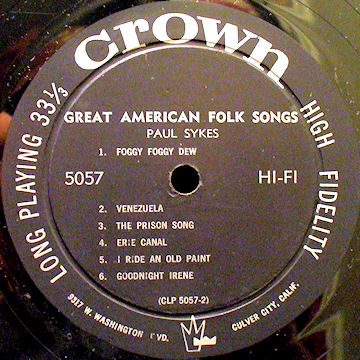


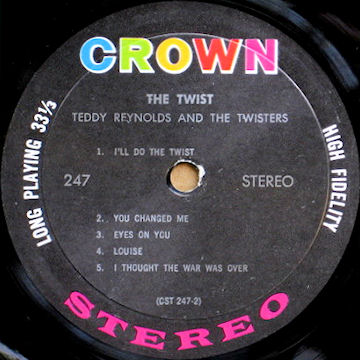
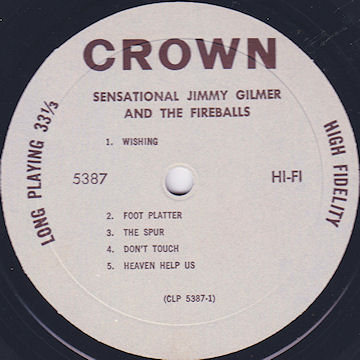

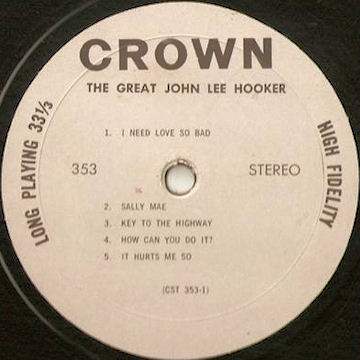
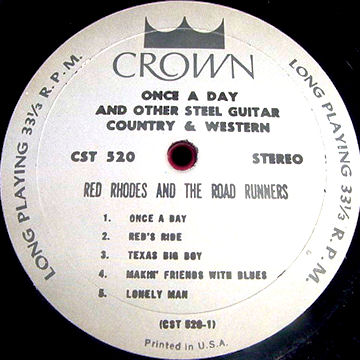
 On to the Crown Album Discography, Part 2 Crown CLP-5100 to
CLP-5199
On to the Crown Album Discography, Part 2 Crown CLP-5100 to
CLP-5199  Back to the Modern/RPM/Crown Story
Back to the Modern/RPM/Crown Story